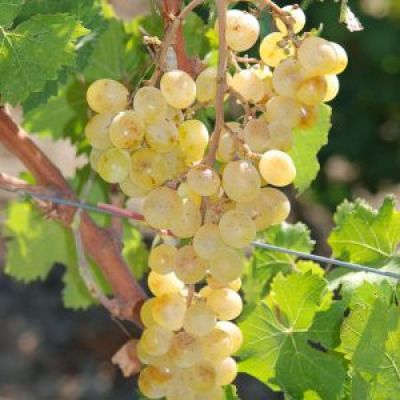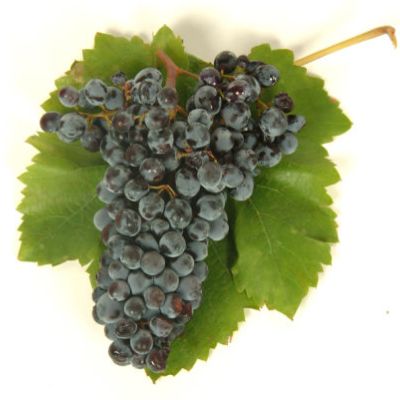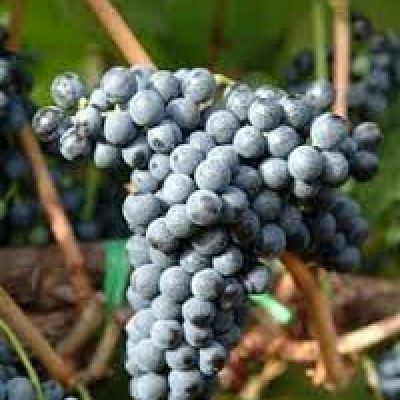Sicily
Sicilian Grapes and Wines
Grapes

Grillo
Grillo is a daughter of Muscat. Its grapey aroma and flavor is milder than in Muscat.
Its major virtue in the vineyard is that it can withstand really high temperatures and drought and still produce copiously.
It also tends to have quite high alcohol contents which makes it a prime candidate for being left on the vine long enough to produce sweet dessert wines (which is why Marsala is classically made from Grillo). Grown as a dry table wine, it needs considerable caution to make anything that isn’t bland and nearly tasteless; thus, care is needed in selecting particular bottling if disappointment is to be avoided. Grillo is not a strongly aromatic or flavored wine, but at its best it is full-bodied, earthy almost to the point of astringency, and can be bottle-aged to benefit. It will have a creamy feel (though with some acidity), and a sense of faint and indistinct but broad-spectrum fruit flavors, tending toward the citrus-y.
Grillo was used in one of Julius Caesar’s favorite wines, the Mamertino of Messina.
Credit to: The Useful Wine Site
Zibibbo
Muscat of Alexandria (“Zibibbo”) is an ancient grape variety grown in the Mediterranean for thousands of years.
It was brought to Sicily by the Phoenicians over 2500 years ago. The grape is sweet and highly aromatic. It has large berries and can be used as a table grape or dried for raisins. Muslims are supposed to abstain from alcohol. Wine grapes were eliminated under Muslim rule. It is said, growing Muscat was permitted because they were being grown for raisins not wine. This enabled it to survive the Arab domination of Sicily. The Arab word for raisin is Z’bib, and in Sicily Muscat is called Zibibbo.
Since it is a very old grape, it has mutated many times producing clones and it has naturally crossed with many other grape varieties. By some counts there are up to 200 grape varieties and its offspring, most not used for commercial production.
Of the commercially important varieties there are at least 5 major clones- Muscat blanc à Petits Grains, Muscat of Alexandria, Muscat of Scanzorosciate, Muscat of Hamburg and Muscat Ottonel. And at least 12 offsprings- Riesling, Gewurztraminer, Traminer, Sylvaner, Muller-Thurgau, Albarino, Torrontes, Viognier, Traminette, Rkatsiteli, Cserszegi Fűszeres and Grillo.
All have a pronounced aroma of grapes, citrus and flowers. These aromas are produced by the terpene class of compounds. In Sicily alone there are two sub clones of Muscat of Alexandria. They have noticeably different growth patterns and concentrations of the aroma compounds.
The Muscat grape is unusual in that it produces a wine which retains much of the flavor of the grape. Most Muscat wines are produced as sweet wines. There are a few dry versions. Some of the better ones are from Alsace, Hungary, and Northern Italy. The flavor profile is aromatic with light notes of peach, kiwi fruit, ginger, honey, and lychee.


Nero d’Avola
Nero d’Avola is the most widely planted grape in Sicily.
The name means black grape from the village Avola. When you think of Sicilian wines, the one that comes to mind is “Nero d’Avola” usually made with 100% of the grape of the same name. In Sicily the grape has three variations and all are full bodied with medium tannins and acid.
Frapatto
Frapatto makes a very fragrant, light colored wine with a thin body.
This is another variety that DNA studies show has Sangiovese for one of its parents. Frappato has low soft tannins with medium acidity. The grape in Sicily has two variations. One is lighter with aromatics of roses, violets, strawberry. The other has black fruit, wild berries, black cherry, white flowers, light anise, and light thyme.

